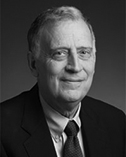
 Ralph John Cicerone
Ralph John Cicerone
2005-2016, NAS President
Ralph Cicerone (1943-2016) was elected president of the Academy for an initial, renewable, term of six years in 2005. He had been elected to the Academy in 1990. As president, he brought with him a very rich and diverse background of experience, although his principal scientific interests had become focused on atmospheric chemistry, geophysics, and environmental science by 2005.
He was born in Pennsylvania and apparently decided initially on a physical and technical career since his choice for undergraduate study was the Massachusetts Institute of Technology, which he completed in 1965. He then proceeded with graduate work at the University of Illinois, obtaining a Ph.D. degree in electrical engineering with a minor in physics in 1970. He obtained his first exposure to aeronomy during this period. His first post-doctoral academic appointments were at the University of Michigan at Ann Arbor and extended over the period from 1970 to 1978. Here he expanded the scientific background at his command to chemistry, particularly atmospheric chemistry. By 1978 he was committed to environmental studies with central emphasis on the chemistry of the ozone layer and factors that had caused a period of global warming starting in the nineteenth century. The years 1978 to 1989 were spent in close association with the Scripps Institution of Oceanography in La Jolla and the National Center for Atmospheric Research in Boulder, Colorado, where he carried out much of the research upon which his scientific reputation is based, including the sources of atmospheric methane and halogen-containing chemicals in the atmosphere.
In 1989, he was appointed to the Daniel G. Aldrich, Jr. chair in earth system science at the University of California at Irvine and to a professorship in the department of chemistry. He became dean of physical sciences of the university in 1998. While demonstrating appropriate leadership in his administrative posts at the university, Cicerone continued to maintain an active research laboratory and serve as international spokesman on environmental science. He also chaired several studies of environmental issues at the National Academy of Sciences. For these activities he was granted a number of prestigious awards such as the Revelle Medal of the American Geophysical Union, the Bower Award of the Franklin Institute and the Einstein Medal for Science from the World Cultural Council.
At the annual spring meeting of the Academy in April of 2006, a year after his election, President Cicerone delivered his first annual review of on-going activities and the ever-growing challenges to be faced in the future. The guiding theme of his address stressed the fact that the mission of the institution is both “timeless and timely.” The address made it evident that he was now as fully in control of his complex office as a president can hope to be.

